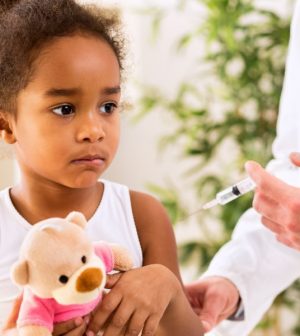- Navigating Your Midlife Crisis: Embracing New Possibilities
- City Raccoons Showing Signs of Domestication
- Mapping the Exposome: Science Broadens Focus to Environmental Disease Triggers
- One Week Less on Social Media Linked to Better Mental Health
- Your Brain Changes in Stages as You Age, Study Finds
- Some Suicide Victims Show No Typical Warning Signs, Study Finds
- ByHeart Formula Faces Lawsuits After Babies Sickened With Botulism
- Switch to Vegan Diet Could Cut Your Greenhouse Gas Emissions in Half
- Regular Bedtime Does Wonders for Blood Pressure
- Dining Alone Could Mean Worse Nutrition for Seniors
Vaccines Saved 37 Million Lives, Mostly Children, Over Past Two Decades

They’re medical miracles: A new report finds that vaccines against 10 major diseases prevented 37 million deaths between 2000 and 2019 in low- and middle-income countries worldwide, with young children benefiting most.
Vaccinations are also projected to prevent a total of 69 million deaths between 2000 and 2030, researchers say.
Their modeling study also shows that vaccination against the 10 diseases — including measles, rotavirus, HPV and hepatitis B — means that people born in 2019 will have a 72% lower risk of death from those diseases over their lifetime.
“There has been a much-needed investment in childhood vaccination programs in low-income and middle-income countries [LMICs] and this has led to an increase in the number of children vaccinated,” explained study co-author Caroline Trotter, an infectious diseases researcher at the University of Cambridge in the U.K.
The greatest benefit of vaccination is among children under age 5. In this age group, deaths from the 10 diseases would be 45% higher without vaccination, according to findings published Jan. 29 inThe Lancet medical journal.
Vaccinations against measles will have the biggest impact, preventing 56 million deaths between 2000 and 2030. Over the lifetime of people born between those years, vaccination will prevent 120 million deaths — 65 million of them in kids under age 5.
The study assessed vaccination programs in 98 countries.
Other pathogens studied were Haemophilus influenzae type B (Hib); Japanese encephalitis (JE); Neisseria meningitidis serogroup A (MenA); Streptococcus pneumoniae; rubella virus; and yellow fever virus (YF).
The findings suggest that if progress continues, the public health gains vaccines provide will continue to increase in coming decades.
Evaluating the impact of these programs on public health is key to continued investment, she said.
“Our modeling has provided robust evidence on the effectiveness of vaccination programs in [low- and middle-income countries] and indicated what might be lost if current vaccination programs are not sustained,” Trotter said in a journal news release.
Corresponding author Neil Ferguson, a professor at Imperial College London, said the findings show the huge public health benefits possible through national vaccination programs.
“By projecting up until 2030 in these 98 countries, we have provided insight on where investments in vaccine coverage should be directed to achieve further gains, for example increasing HPV coverage in girls and pneumococcal conjugate vaccines [PCV] coverage in children under 5 will have the most impact according to our modeling,” he said.
More information
The World Health Organization has more on vaccines.
SOURCE: The Lancet, news release, Jan. 29, 2021
Source: HealthDay
Copyright © 2025 HealthDay. All rights reserved.










